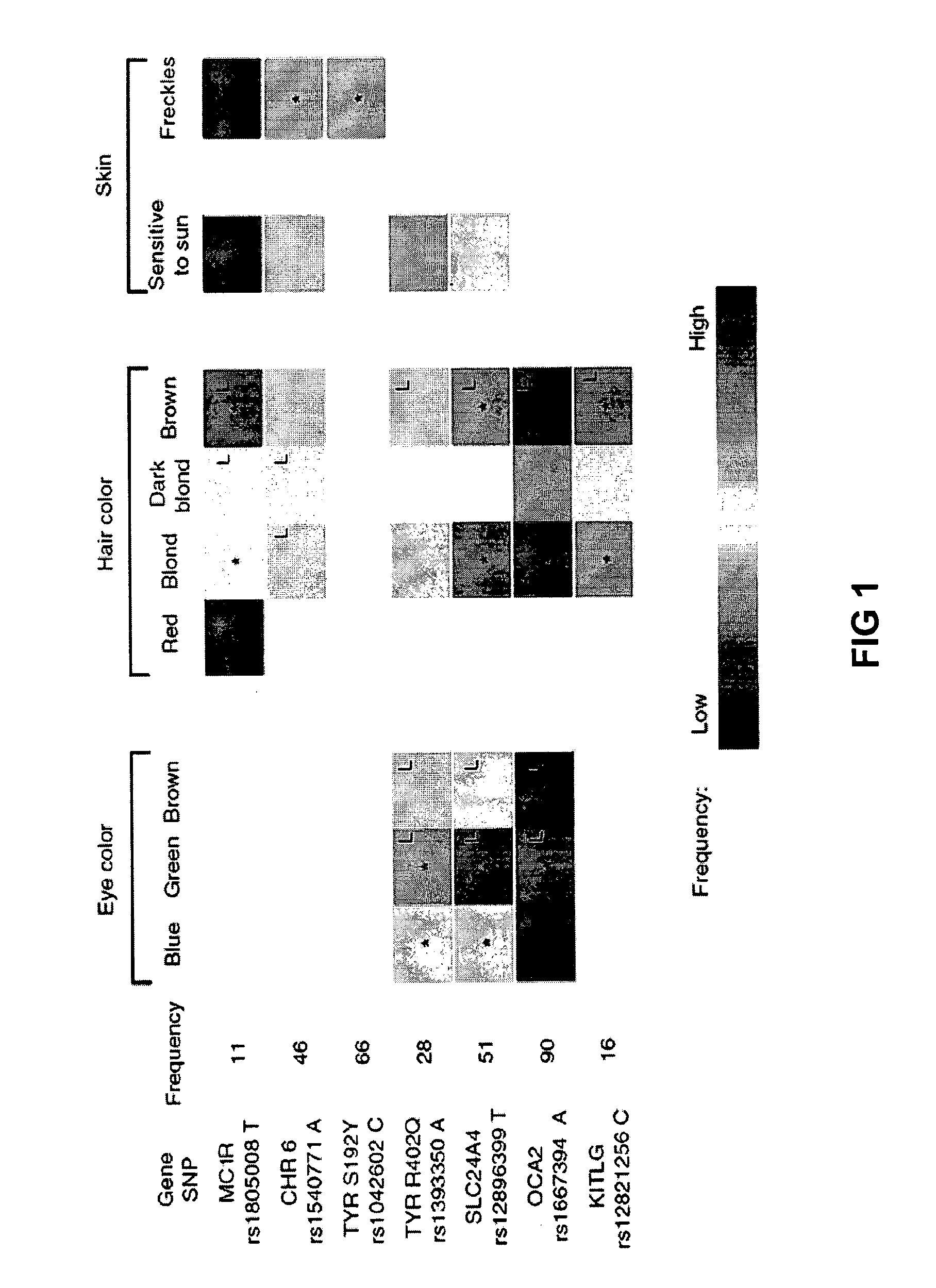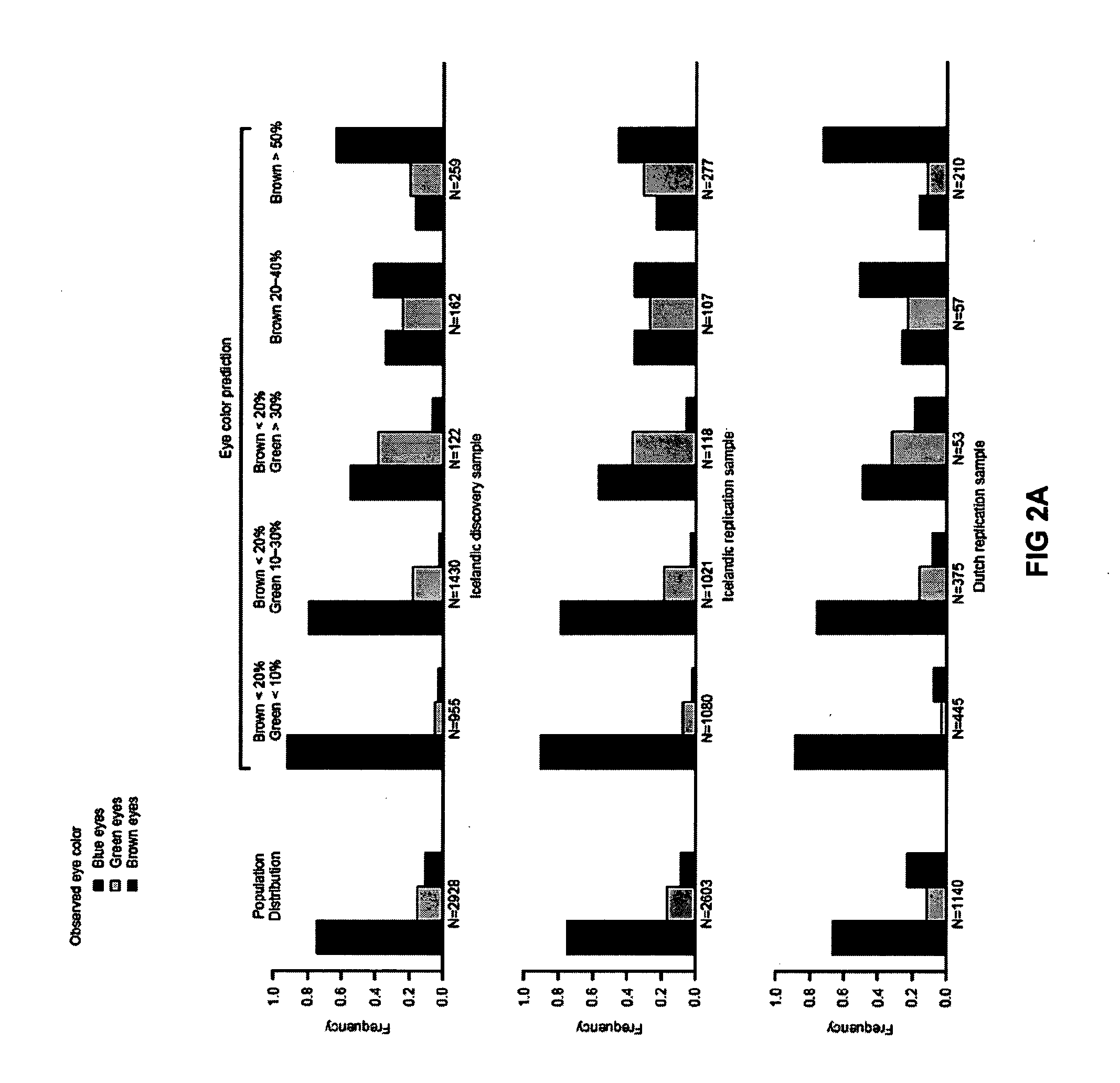Sequence variants for inferring human pigmentation patterns
- Summary
- Abstract
- Description
- Claims
- Application Information
AI Technical Summary
Benefits of technology
Problems solved by technology
Method used
Image
Examples
example 1
Variants Associated with Hair, Eye and Skin Pigmentation
[0302]A genome-wide association scan for sequence variants influencing hair color, eye color, freckles and skin sensitivity to sun was performed, using a set of 317 thousand SNPs genotyped in 2,986 Icelanders. Promising SNPs were tested in replication samples from 2,718 Icelanders and 1,214 Dutch individuals.
[0303]Methods
[0304]Icelandic Samples
[0305]A total of 2,986 Icelandic adults, recruited through cardiovascular, neoplastic, neurologic and metabolic study projects, were genotyped for 317,000 SNPs using the HumanHap300 BeadChip (Illumina, San Diego, Calif., USA). These studies were approved by the Data Protection Commission of Iceland and the National Bioethics Committee of Iceland. Written informed consent was obtained from all participants. Personal identifiers associated with phenotypic information and blood samples were encrypted using a third-party encryption system as previously described (Gulcher, J. R., et al., Eur J...
example 2
Identification of Additional Variants Associated with Hair, Eye and Skin Pigmentation
[0362]A follow-up analysis of a genome-wide association scan for sequence variants influencing hair color, eye color, freckles and skin sensitivity to sun was performed. Methods used were as described in Example 1 described in detail in the above, with the primary difference that a total of 4611 individuals from the Icelandic population were analyzed.
[0363]Results
[0364]In Table 10, we shows results of all SNPs that were found to be associated with at least one pigmentation trait to a genome-wide significant level, as defined by the threshold of P−7. All the markers indicated in the Table are thus useful for predicting at least one pigmentation trait, and are thus useful in the Methods described herein. Furthermore, we identified all markers that are in linkage disequilibrium with at least one of the markers shown in Table 10. As discussed in detail in the foregoing, markers that are in linkage diseq...
example 3
Identification of Variants Associated with Melanoma
[0365]A follow-up analysis of variants associated with freckles and skin sensitivity to sun was performed. In particular, 484 individuals diagnosed with malignant melanoma cancer were assessed for the particular markers described in Example 1 and Example 2. The analysis revealed significant association of marker rs6060043 to melanoma, with an increased risk of heterozygous carriers of 39%, as indicated in Table 12. This marker is therefore useful for diagnosing a risk of, or a susceptibility to, melanoma. Malignant cutaneous melanoma was diagnosed according to ICD-10 classification, and obtained from the Icelandic Cancer Registry.
[0366]The marker shows correlation to sun sensitivity of the skin, to freckles and to red hair. This is consistent with the effect on melanoma susceptibility, since those sensitive to sun exposure are at increased risk of developing melanoma cancer. Furthermore, red hair is frequently associated with sun se...
PUM
| Property | Measurement | Unit |
|---|---|---|
| Current | aaaaa | aaaaa |
| Digital information | aaaaa | aaaaa |
| Electric dipole moment | aaaaa | aaaaa |
Abstract
Description
Claims
Application Information
 Login to view more
Login to view more - R&D Engineer
- R&D Manager
- IP Professional
- Industry Leading Data Capabilities
- Powerful AI technology
- Patent DNA Extraction
Browse by: Latest US Patents, China's latest patents, Technical Efficacy Thesaurus, Application Domain, Technology Topic.
© 2024 PatSnap. All rights reserved.Legal|Privacy policy|Modern Slavery Act Transparency Statement|Sitemap



